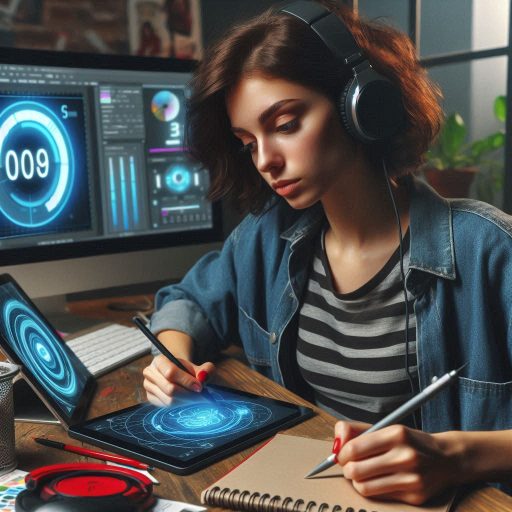Introduction
Costume design is the creation of clothing and accessories worn by actors on stage or screen.
It enhances the character and story, reflecting time periods, personalities, and settings.
Costume design transforms a character‘s appearance, influencing how audiences perceive and connect with them.
Art plays a crucial role in costume design.
It helps designers conceptualize and visualize garments that embody the essence of characters.
Art provides inspiration through historical fashion, cultural symbols, and color theory.
By integrating artistic principles, costume designers create visually compelling and contextually accurate outfits.
Famous examples highlight art’s influence on costume design.
In the film “Moulin Rouge!”, costume designer Catherine Martin used vibrant colors and eclectic styles to reflect the bohemian Parisian setting.
The costumes were inspired by art movements like Art Nouveau and Rococo.
In theater, the costumes in ‘The Lion King‘ were designed with a nod to African art and textiles, enhancing the production‘s cultural authenticity.
These examples show how art can shape and define the visual language of costume design.
In summary, costume design merges creativity and functionality, with art providing the foundation for its impact.
Designers draw from various artistic sources to create memorable and meaningful costumes.
These designs not only enhance storytelling but also contribute to the overall aesthetic experience of film and theater.
Historical background of art in costume design
Art has always been an integral part of costume design throughout history.
Let’s delve into the key periods where art played a significant role in shaping costumes.
Ancient Civilizations
In ancient civilizations, such as Egypt and Greece, art played a crucial role in designing costumes for theatrical performances and ceremonies.
Artists were responsible for creating elaborate and intricate costumes that reflected the culture and traditions of the time.
Renaissance Era
During the Renaissance era, art and costume design were closely intertwined.
Transform Your Career Today
Unlock a personalized career strategy that drives real results. Get tailored advice and a roadmap designed just for you.
Start NowArtists like Leonardo da Vinci and Raphael created sketches and paintings that inspired the intricate costumes worn by nobility.
The use of rich fabrics, intricate embellishments, and detailed embroidery became a hallmark of Renaissance fashion.
Baroque Period
In the Baroque period, art and costume design reached new heights of extravagance.
Costumes were opulent, featuring lavish fabrics like silk and velvet, intricate embroidery, and ornate accessories.
Artists worked closely with designers to create costumes that were not only visually stunning but also reflected the opulence and grandeur of the Baroque era.
19th Century
During the 19th century, art movements like Romanticism and Impressionism influenced costume design.
Artists like Eugene Delacroix and Edgar Degas created paintings that showcased the vibrant colors and flowing fabrics of the Romantic era.
These paintings inspired designers to create costumes that captured the essence of the artistic movements of the time.
Modern Era
In the modern era, art continues to play a significant role in costume design.
Designers draw inspiration from contemporary art movements, such as Abstract Expressionism and Pop Art, to create avant-garde and innovative costumes.
Artistic collaborations between designers and artists have resulted in groundbreaking and visually striking costume designs that push the boundaries of traditional fashion.
Overall, art has been a driving force in shaping costume design throughout history.
From ancient civilizations to the modern era, art has influenced the way costumes are designed, creating a visual language that communicates culture, identity, and creativity in the world of fashion.
Read: Building a Brand as a Multimedia Artist
Influence of art movements on costume design
Art movements have profoundly shaped costume design, reflecting the evolving aesthetics of their times.
Surrealism, Art Deco, and Impressionism each brought unique influences that continue to inspire modern costume design.
How art movements like surrealism, Art Deco, and Impressionism have influenced costume design
Surrealism revolutionized costume design with its dreamlike, imaginative forms.
Artists like Salvador Dal‘ and Ren‘ Magritte challenged reality, inspiring designers to experiment with bizarre and whimsical elements.
For instance, Dal‘s iconic melting clocks from ‘The Persistence of Memory‘ inspired costumes with distorted, fluid shapes and unconventional textures.
Showcase Your Business Today
Reach thousands of readers actively exploring professional services. Publish your business profile and grow your audience now.
Publish NowDesigners embraced these surreal elements to create garments that defied traditional form and structure, echoing the movement‘s essence of unpredictability and fantasy.
Art Deco introduced sleek, geometric designs and opulent materials in the 1920s and 1930s.
This movement celebrated luxury and modernity, influencing costume design with its emphasis on symmetry, streamlined silhouettes, and rich fabrics.
The glamorous gowns of this era often featured intricate beadwork and metallic finishes, reflecting Art Deco‘s fascination with sophistication and progress.
Notable examples include the costumes in films like ‘The Great Gatsby,‘ where the opulence of Art Deco is vividly captured in the lavish designs and intricate detailing.
Impressionism, with its focus on light and color, impacted costume design by encouraging designers to explore innovative use of fabrics and dyes.
Artists like Claude Monet and Edgar Degas captured fleeting moments and the effects of light, influencing designers to use lighter, airy materials and fluid forms.
The Impressionist emphasis on capturing a moment‘s mood led to costumes that featured soft, flowing lines and subtle, ethereal colors, often reminiscent of the impressionistic brushstrokes seen in art.
Specific examples where artists’ work translated into costume design
Each of these art movements has left an indelible mark on costume design, infusing it with their distinct styles and philosophies.
By translating artistic principles into wearable art, designers create costumes that not only reflect historical aesthetics but also push the boundaries of fashion.
Read: Top Trends in Digital Art and Multimedia Design
Collaboration between artists and costume designers
Collaboration between artists and costume designers is crucial in the world of costume design.
Artists play a significant role in influencing the design of costumes.
Here are some key points that highlight the importance of collaboration between artists and costume designers:
Exchange of Ideas
Artists and costume designers often come from different backgrounds and bring unique perspectives to the table.
This exchange of ideas can lead to innovative and creative costume designs.
Understanding the Vision
Costume designers work closely with artists to understand their vision for a particular project.
By collaborating, costume designers can bring that vision to life through costumes.
Incorporating Artistic Elements
Artists often have specific artistic elements that they want to see incorporated into the costumes.
Costume designers can use their skills to translate these elements into wearable costumes.
Enhancing the Storytelling
Costumes play a crucial role in storytelling, and collaboration between artists and costume designers can enhance this aspect.
By working together, they can create costumes that effectively convey the story and characters.
Pushing Boundaries
Collaboration between artists and costume designers allows for pushing boundaries and exploring new ideas.
This can result in groundbreaking and visually stunning costume designs.
In a nutshell, the collaboration between artists and costume designers is essential for creating unique, visually appealing, and meaningful costumes.
By working together, artists and costume designers can bring their creative visions to life on stage or screen.
Read: Common Challenges for Multimedia Artists and Solutions

Art techniques used in costume design
How art techniques like textile painting, embroidery, and printmaking are used in costume design
Art techniques play a crucial role in costume design, adding depth and uniqueness to every piece.
Textile painting allows designers to create intricate, personalized patterns directly on fabric.
This technique offers endless possibilities for color combinations and abstract designs that transform simple materials into stunning costumes.
Costumes in theater productions often feature textile paintings to reflect specific time periods or cultural influences.
Embroidery is another art form widely used in costume design.
It involves stitching patterns, textures, and images onto fabric.
Embroidery not only adds elegance and detail but also enhances the tactile quality of a costume.
For example, embroidered floral patterns can bring historical costumes to life, adding realism and visual appeal.
In fantasy genres, embroidery is often used to create intricate symbols or mystical elements on characters’ costumes.
Printmaking is another powerful tool in the costume designer‘s arsenal.
Screen printing and block printing are used to replicate patterns consistently across multiple pieces.
This technique is especially useful for designing costumes for large ensembles, ensuring a uniform yet artistic look.
For example, in movies or theater productions set in ancient times, designers use printmaking to recreate traditional fabrics with authenticity.
Showcase Your Business Today
Reach thousands of readers actively exploring professional services. Publish your business profile and grow your audience now.
Publish NowExamples of how these techniques enhance the overall aesthetic of costumes
These techniques, when combined, elevate costume design to an art form.
Textile painting adds a personal touch, embroidery introduces intricate detailing, and printmaking offers consistency and mass reproduction.
For instance, in a fantasy film, textile painting can depict magical landscapes, while embroidery showcases royal insignias, and printmaking provides cultural motifs.
By incorporating these art techniques, costume designers create pieces that tell stories visually, enhancing the overall aesthetic of a production.
These creative processes allow costumes to resonate emotionally, contributing to the narrative and helping bring characters to life.
Art and costume design are intrinsically linked, working together to create visual masterpieces.
Read: The Future of Multimedia Art and Design
Art as inspiration for character development
How pieces of art inspire character traits and personalities
Art has the power to evoke emotions and spark creativity in costume designers.
By studying various art forms such as paintings, sculptures, and photographs, costume designers can gain valuable insight into different aesthetics, styles, and themes that can influence the development of a character’s personality and traits.
For example, a vibrant and colorful painting may inspire a costume designer to create a character with a bold and expressive personality, while a serene and minimalist sculpture may lead to the development of a calm and understated character.
How costume designers use art to develop the look and feel of a character
Costume designers often look to art for inspiration when creating the visual appearance of a character.
By studying the colors, shapes, textures, and patterns in artwork, costume designers can effectively translate the essence of a character into their costume design.
For instance, a costume designer may draw inspiration from the intricate patterns and vibrant colors found in a traditional tapestry to create a rich and elaborate costume for a character, or they may use the clean lines and minimalist aesthetic of a modern sculpture to design a sleek and contemporary look.
Art serves as a valuable resource for costume designers, enabling them to develop unique and visually compelling designs that enhance the overall storytelling of a character.
Influence of art in fantasy and sci-fi costume design
How art has influenced the creation of fantastical and futuristic costumes
Art plays a crucial role in creating the fantastical and futuristic costumes seen in fantasy and sci-fi films.
Designers draw inspiration from various art forms, transforming visions into wearable art.
Sculptures, paintings, and even abstract art inspire the shapes and textures of costumes, adding depth and originality to these creations.
Artists’ imaginations bring worlds to life, influencing costume designs that transcend reality.
These costumes embody the creativity needed to depict characters from otherworldly realms or futuristic societies.
Designers fuse artistic concepts with practical elements, making costumes not only visually stunning but also functional for actors.
How artists’ visions have shaped iconic costumes in fantasy and sci-fi films
Many iconic fantasy and sci-fi costumes were shaped by artists‘ unique visions.
For instance, the elaborate outfits in “Star Wars” drew inspiration from surrealist art.
This blend of fantasy and surrealism made the costumes appear both familiar and alien.
Similarly, in films like “The Fifth Element,” the costumes reflect avant-garde art, pushing the boundaries of traditional fashion design.
In fantasy, costumes often evoke themes of mythology and magic.
Artists use symbolism to represent elements like power or mystery, influencing costume colors, shapes, and materials.
In sci-fi, futuristic costume designs explore the intersection of technology and fashion.
Many designs envision what clothing might look like in distant futures or parallel universes.
Ultimately, art remains a powerful tool in costume design for fantasy and sci-fi films.
It enriches the visual storytelling, allowing viewers to immerse themselves fully in these imaginative worlds.
The influence of art ensures these costumes resonate long after the films end, leaving a lasting visual impact on audiences worldwide.
Learn More: The Intersection of Art and Architecture in Public Spaces
Art as a storytelling tool in costume design
When it comes to costume design, art plays a crucial role in telling a story through the characters’ attire.
Costumes are not just pieces of clothing; they are visual representations of the character’s personality, background, and emotions.
In this section, we will explore how art serves as a powerful storytelling tool in costume design, conveying themes and emotions effectively.
Conveying Themes and Emotions
Artistic elements such as color, texture, shape, and pattern can be used to convey themes and emotions in costume design.
For example, a character dressed in vibrant colors and intricate patterns may represent vitality and passion, while a character in dark, subdued tones may convey mystery or melancholy.
The choice of fabric can also evoke specific emotions, with luxurious materials like silk and velvet suggesting wealth and power, while rough textures like burlap or denim may signify simplicity or ruggedness.
Symbolism is another artistic element that costume designers often incorporate into their work to communicate deeper meanings.
For instance, a character wearing a red dress may symbolize love or passion, while a character in a white gown could represent innocence or purity.
Showcase Your Business Today
Reach thousands of readers actively exploring professional services. Publish your business profile and grow your audience now.
Publish NowAccessories such as jewelry, hats, or shoes can further enhance the storytelling by adding layers of meaning to the character’s attire.
Examples of Artists’ Work in Costume Design
Costume designers frequently draw inspiration from various art forms, including paintings, sculptures, and photography, to create unique and visually compelling costumes.
Let’s take a look at some examples of how artists’ work is incorporated into costume design to enhance storytelling:
- Leonardo da Vinci: The intricate patterns and designs found in da Vinci’s paintings have inspired costume designers to create elaborate and ornate costumes for period dramas or fantasy films.
- Frida Kahlo: Kahlo’s vibrant use of color and bold clothing choices have influenced costume designers to create costumes that reflect a character’s strength, individuality, and cultural heritage.
- Andy Warhol: Warhol’s iconic pop art style has inspired costume designers to create bold, graphic costumes that make a statement and stand out on screen.
By incorporating elements of these artists’ work into costume design, designers can effectively enhance the storytelling and create visually striking characters that resonate with the audience.
The collaboration between art and costume design is essential in bringing characters to life and conveying the narrative of the story through their attire.
All in all, art serves as a powerful storytelling tool in costume design, allowing designers to convey themes and emotions effectively through the characters’ attire.
By drawing inspiration from various art forms and incorporating artistic elements into their work, costume designers can create visually compelling costumes that enhance the narrative of the story and bring characters to life on screen.
See Related Content: Top Concept Art Blogs and Communities to Follow
Conclusion
Art plays a crucial role in costume design, weaving creativity into every stitch.
By blending artistry with functionality, designers transform concepts into visually compelling costumes.
Artistic elements like color, texture, and form breathe life into garments, making them integral to storytelling.
Costume design is not just about attire; it‘s about creating a character’s identity.
Art allows designers to communicate personality, era, and mood through clothing.
This transformation from mere fabric to a character-defining outfit highlights the power of artistic influence.
The impact of art in costume design extends across various media.
In film, artful costumes enhance character development and narrative depth.
On stage, they elevate performances, making characters more relatable and memorable.
In television, costumes become iconic, leaving a lasting impression on viewers.
Artistic influence ensures costumes are more than functional; they are expressive and evocative.
Designers use art to ensure costumes resonate emotionally with audiences, whether in film, theater, or television.
This connection amplifies the storytelling experience, making it richer and more immersive.
Art in costume design is indispensable.
It transcends mere visual appeal, contributing significantly to how audiences perceive and connect with characters.
Without this artistic touch, costumes would lack the depth and nuance that make them truly memorable.
As media evolves, the role of art in costume design remains central, continually shaping how stories are told and experienced.
By embracing artistic influence, costume designers create garments that are not just worn but remembered.
Art transforms costume design from a practical necessity into an essential storytelling tool, making every character‘s wardrobe a vital part of their story.
[E-Books for Sale]
The Big Book of 500 High-Paying Jobs in America: Unlock Your Earning Potential
$19.99 • 500 High-Paying Jobs • 330 pages
Explore 500 high-paying jobs in America and learn how to boost your career, earn more, and achieve success!
See All 500 High-Paying Jobs of this E-Book
1001 Professions Without a Degree: High-Paying American Jobs You Can Start Now
$19.99 • 1001 Professions Without a Degree • 174 pages
Discover 1001 high-paying jobs without a degree! Unlock career tips, skills, and success strategies for just $19.99!




